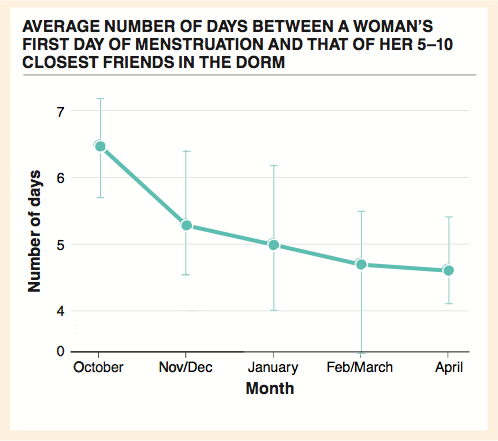Chapter 25. Chapter 25 Graphic Content
Introduction
Graphic Content
true
true
You must read each slide, and complete the question on the slide, before proceeding to the next one.

Instructions
Review the information provided in the graph to answer each question below.
After submitting your answer, you will be provided feedback to check if your response is correct.
(This activity contains 7 questions.)
Question 25.1

In October, the average number of days between a woman’s “first dayof menstruation” and those of her 5-10 closest friends in her dorm was 6.5 days. In April, this number was about 4.7. This is a decrease of approximately 28%.
Question 25.2

If all women had a 28-day menstrual cycle, the highest value that would be possible on the y-axis is 14. This is because if a woman’s first day of menstruation is more than 14 days later than her friend’s (for example, 16 days later), it would then be considered to be some smaller number of days earlier than her friend’s next “first day of menstruation.” In other words, if her first day of menstruation occurs 16 days after her friend’s first day, it would be reported as 12 days earlier than her friend’s next “first day of menstruation.”
Question 25.3

The fact that women on the pill were not excluded from this study makes the results a bit more convincing. This is because it is likely that all women on the pill would have 28-day menstrual cycles that could not be altered. Consequently, the phenomenon of menstrual synchrony is not occurring among women on the pill, and so including them in the data makes it more difficult to detect the phenomenon among the other women. It’s hard to be certain why women on the pill were included in this study. One possibility is the fact that, although their cycles could not change in length, they still were part of the environment of the other women and were potentially influencing the cycle length of those women—causing the cycles of women not on the pill to become more synchronized with cycles of those on the pill.
Question 25.4

Just because these ideas and data were developed by an undergraduate should not influence our interpretation of them. One of the strengths of scientific thinking is that any study can be evaluated solely on its merits. On their own, the academic qualifications of the researcher do not make a study more or less accurate. That said, it might be true that the more experience researchers have, the more likely that they may anticipate difficulties in interpretation or appreciate complex issues relating to the development of experimental controls—thus enabling them to design a better-controlled experiment or to conduct a more powerful analysis of the results.
Question 25.5

The break in the y-axis indicates that part of the scale (from 0 to 3) has been omitted. This was likely done because none of the data points or their associated error bars fell in that range, and so including this range on the graph would just reduce the proportion of the graph devoted to actual data. If this break were not made, however, the magnitude of the change conveyed by the data would appear smaller. This is because in the current form, the entire graph can cover the range of 4 to 7 days. If the graph covered 0 to 7 days, the portion in which the data appear would be only about half as large. As a consequence, that magnitude of the change from October to April would appear less steep (although its actual value would remain unchanged).
Question 25.6

The vertical lines through each data point represent the variation around the average. In other words, while the average number of days between a woman’s “first day of menstruation” and that of her 5-10 closest friends in the dorm was 6.5 days, in some cases it was larger and in some cases it was smaller. The size of the error bars, which probably represent the standard deviation around the mean, gives an indication of how much variation there was among individuals in this measure. If the error bars were twice as long, it would indicate much more variation from one woman to another in the number of days between her first day of menstruation and those of her 5-10 closest friends. This would decrease our confidence that the increased synchrony observed represented a true physiological phenomenon as opposed to a coincidental change in means due to random chance.
Question 25.7

The take-home message of this graph is that over the course of less than one academic year, women living together in dorms tend to become synchronized in their menstrual cycles, as evidenced by a reduced difference in the number of days between their first days of their menstrual cycles. It would be helpful to see data from women living together for longer periods than that shown. It also would be helpful to see data from these same women after they stop living together at the end of the academic year. We would expect, gradually, the average number of days to increase between a woman’s “first day of menstruation” and those of her 5-10 closest friends in the dorm (but who are no longer living together), until it is no different from the number determined at the beginning of this study.
Activity results are being submitted...